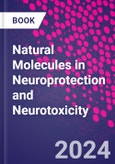Natural Molecules in Neuroprotection and Neurotoxicity brings together research in the area of natural compounds and their dual effects of neuroprotection and neurotoxicity when interacting with brain cells. This two volume set is organized into four sections that address molecular mechanism underlying neuroprotection and neurotoxicity, neuroprotection mediated by natural molecules, neurotoxicity induced by natural compounds and nanotechnology-related strategies utilized in neuroprotection.
Written by well-known researchers all over the world, chapters provide an in-depth analysis of numerous molecules, such as algae, plant and fungus-derived molecules, and comprehensively discuss their mechanisms of action and possible clinical applications. This set provides an essential reference for researchers and clinical scientists interested in the effects of natural compounds on the human health and disease.
Table of Contents
Volume 1 Part I. Overview on Neuroprotection and Neurotoxicity 1. Natural Molecules in Neuroprotection and Neurotoxicity in Neurodegenerative Diseases Ines Moreno-Gonzalez, Ines Lopez del Castillo, Laura Vegas-Gomez and Joana A. Loureiro 2. The Sea as a Source of Neuroprotective and other Health-Protective Molecules 3. Can venoms be used in neuroprotection? 4. Polyphenols-gut microbiota interplay in neuroprotection 5. Medical Potentials of Natural Neuroprotectants Derived from Herbal Extracts and Their Phytochemicals 6. Redox impairment in affective disorders and therapeutic potential of phenolic bioactive 7. How the endoplasmic reticulum staggers towards failure: New targets for neuroprotection 8. Modulation of neuroinflammation by natural molecules 9. Epigenetic modulations induced by natural molecules 10. Nutraceuticals and enteric glial cells 11. Natural molecules in the treatment of schizophrenia 12. Anti-tumor effects induced by natural molecules in the brain 13. Understanding the Neurogenic Potential of Flavonoids and their Application for Neurodegenerative Diseases 14. Transcriptomics in Neurotoxicity and Neuroprotection Part II. Neuroprotection mediated by natural molecules Algae-derived Molecules 15. Neuroprotection induced by Fucoxanthin 16. Phycocyanobilin Animal-derived Molecules 17. Bee venom 18. Frog-derived peptides and neuroprotection 19. Snake venom 20. Spider venom Human Endogenous Molecules 21. Acetyl-L-carnitine 22. Coenzyme Q10 23. Creatine in neuroprotection and neurotoxicity 24. Neuroprotection induced by erythropoietin 25. Neuroprotection by estrogens 26. Sex hormones in neuroprotection and neurodegeneration 27. Melatonin 28. Neuroprotection induced by neurotrophic factors 29. Neuroprotective Nucleosides 30. Taurine Role in Neuroprotection Part III. Natural Molecules-associated Nanotechnology-related Strategies Utilized in Neuroprotection 50. Neuroprotection through Nanotechnology 51. Natural antioxidant nanoparticles in neuroprotection 52. Nanomaterials-based approach in stroke 53. Nanoparticles and the treatment of depression 54. Anti-tumor effects of natural molecules in the brain: a nanotechnology-based approach Part IV. Natural Molecules-associated Nanotechnology-related Strategies Utilized in Neuroprotection 50. Neuroprotection through Nanotechnology 51. Natural antioxidant nanoparticles in neuroprotection 52. Nanomaterials-based approach in stroke 53. Nanoparticles and the treatment of depression 54. Anti-tumor effects of natural molecules in the brain: a nanotechnology-based approach Volume 2 Part I. Neuroprotection mediated by natural molecules Plant-derived Molecules 1. Neuroprotection induced by agathisflavone 2. Alkaloids 3. Andrographolide 4. Anthocyanins 5. Neuroprotection induced by apigenin 6. Ascorbic acid 7. Neuroprotection induced by baicalein and baicalin 8. Neuroprotection induced by biochanin A 9. Epigallocatechin gallate 10. Carnosic Acid, mitochondria, and neuroprotection 11. Neuroprotection induced by catechins in aging 12. Neuroprotection induced by chrysin 13. Citrus Flavonoids Mechanisms of neuorprotection and preclinical evidence 14. Neuroprotection induced by coumarins in central nervous system disease models 15. Curcumin 16. Neuroprotection induced by dimethyl fumarate 17. Neuroprotection induced by edible oils 18. Garlic components 19. Ginger components 20. Green tea polyphenols for Neuroprotection: Effects against Alzheimer's and Parkinson's Diseases 21. Honey compounds 22. Neuroprotective actions of hydroxytyrosol 23. Hydroxytyrosol: Focus on the anti-neuroinflammatory action 24. Kaempferol 25. Neuroprotection induced by lycopene 26. Neuroprotection induced by terpenes: focus on Alzheimer's disease and Parkinson's disease 27. Olive oil components 28. Omega-3 polyunsaturated fatty acids 29. Neuroprotection induced by phloretin and phloridzin 30. Phytomelatonin 31. Quercetin 32. Neuroprotection induced by salvianolic acids 33. Sulforaphane 34. Effects of tocopherols and tocotrienols on microglia-mediated neuroprotection 35. Vanillin Part II. Neurotoxicity Induced by Natural Molecules: Animals and Humans Animal-derived Molecules 43. Scorpion toxins 44. Anura-derived molecules from Pampa Biome Human-endogenous Molecules 45. Cellular and molecular mechanisms of ammonia-induced neurotoxicity: A neurotherapeutic prospect 46. Biliverdin and bilirubin 47. Neurotoxicity induced by glycotoxins 48. Amyloids as endogenous toxicants in neurodegenerative diseases 49. Neurotoxicity induced by lipid metabolism associated endogenous toxicants
Authors
Marcos Roberto de Oliveira Professor, Department of Biochemistry, Federal University of Rio Grande do Sul, Universidade Federal do Rio Grande do Sul (UFRGS), Instituto de Ci�ncias B�sicas da Saude (ICBS), Departamento de Bioqu�mica, Rua Ramiro Barcelos, Brazil. Dr Oliveira PhD earned his bachelor's degree in Biological Sciences at Federal University of Rio Grande do Sul (UFRGS) in 2005, followed by a Master's and a Ph.D. in Biochemistry from the same institution. His research focuses on the neuroprotection mediated by natural molecules and involves studies on mitochondrial physiology, redox biology, bioenergetics, and inflammation in both in vitro and in vivo experimental models.Dr Oliveira has published numerous articles on peer-reviewed Journals, including Molecular Neurobiology, Chemico-Biological Interactions, Biotechnology Advances, and Oxidative Medicine and Cellular Longevity. He has also edited a book on the effects of plant molecules on the mitochondria Mitochondrial Physiology and Vegetal Molecules: Therapeutic Potential of Natural Compounds on Mitochondrial Health and a book on the role of mitochondrial dysfunction in both neurological disturbances and intoxication Mitochondrial Dysfunction and Nanotherapeutics: Aging, Diseases, and Nanotechnology-Related Strategies in Mitochondrial Medicine.








